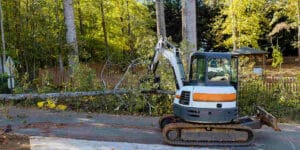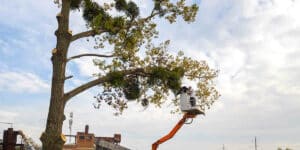Do you have a tilting tree in your yard? If so, you may wonder, “How far can a tree lean before it falls?” As Nashville’s reliable tree service, Tree Care Inc. is here to teach you how to identify, deal with, and care for hazardous trees to avoid problems. Keep reading to learn everything you should know and how we can help.
Reasons Trees Lean
Trees can lean for several reasons, and not all present a cause for concern.
Natural Growth
Trees naturally grow toward a light source because they need the sun for nutrition. If the tree resides in an area with significant shade, it might tilt in the direction of the sun as it grows. As long as the lean isn’t severe and you don’t notice any other problems, the tree shouldn’t pose a threat to your safety.
Consistent or Strong Winds
Frequent bursts of extreme wind or consistent exposure to strong winds can cause problems with the roots or soil, causing significant leaning in your tree over time. This usually puts the tree in danger of falling, so call us for tree service promptly.
Soil and Root Issues
One of the most common causes of a leaning tree is problems with the soil or roots. Wind and rain can wash away the soil, which leaves the tree’s roots exposed and unable to support the tree. Poor soil nutrition can also lead to weak roots, which can easily rip from the ground during a storm.
If you see more than a few tree roots coming from the ground, consider it a tree emergency.
Physical Damage
Damage to a tree from heavy equipment or a storm can throw it off balance, causing it to grow at a lean. In this situation, you should call a professional to determine whether the tree is dangerous.

Signs Your Tree Poses a Threat
How can you tell between a benign lean and a dangerous one? Look for these signs:
- Angle: If your tree leans more than 15 degrees, regardless of health or damage, the pressure will become too much for the trunk. While it may last weeks or months before it falls, the worst-case scenario is practically inevitable at that angle.
- Damage: If you notice damage to the trunk or roots, even if the tree’s angle isn’t severe, it likely has structural issues that will cause it to fall.
- Health: If you notice an insect infestation, rotting branches, or discolored leaves, your tree is sick. While an arborist may restore it to health, a sick tree often has structural support issues.
The Danger of a Leaning Tree
How far can a tree lean before it falls? If you see your tree leaning more than 15 degrees, you should act immediately to mitigate the risks it poses to your property and family.
Falling Risk
The most obvious risk of a leaning tree is its high chance of falling. A fallen tree is more than just an eyesore; it can damage your building or vehicles, take out other trees, or hit a person or pet.
Spreading Disease
If your tree leans from a disease or insect infestation, the problem could spread to your other trees or plants. Some insect problems, like termites, could also reach your home. Even if the tree hasn’t fallen yet, if you notice it’s in bad health, ask a certified arborist for help.
Reduced Curb Appeal
While it may not feel like your most important consideration, a leaning tree, especially one that is damaged or in poor health, can reduce your curb appeal and property value. No future homeowner wants to deal with a hazardous tree, so consider removing it before selling your home.
Dealing With a Leaning Tree
If you notice a tree with a dangerous lean, you have a few options for dealing with it.
Tree Removal
Though removing your tree is the most drastic solution, if the tree is beyond help, this is the safest solution by far. Never attempt to remove a tree by yourself. It requires special equipment, knowledge, and techniques, especially when it has a significant tilt.
Uprighting Techniques
Depending on your tree’s overall health, condition, and angle, a qualified specialist can often correct the lean and help the tree grow straighter. This technique involves using stakes and stabilizing rope to support the tree while reinforcing the soil and root system to restore strength to the tree’s structure.
Damage and Health Interventions
Depending on the nature and severity of the tree’s damage or disease, an arborist can often help the tree heal. This reduces the likelihood of falling, making it potentially eligible for uprighting.
Caring for Your Tree
To fully enjoy the benefits of trees on your property, you can minimize the risk of most tree problems with preventive tree care and the following techniques.
Supply Nutrition
Healthy soil is crucial to keeping your tree healthy. Every soil is different and requires a different infusion of nutrients to provide what your tree needs to stay strong. Our certified arborists can create the perfect fertilizer for your yard.
Trim and Prune
You should trim or prune your trees as needed, but at least every three years. Trimming your trees prevents hazardous overgrowth that could encroach on your home or powerlines. Pruning eliminates diseased or damaged areas and prevents their detrimental effects from spreading to the rest of the tree.
Regular Inspections
Schedule annual inspections for your trees. This helps the experts identify problems early and reverse issues before they permanently affect your tree beyond the point of no return.
Contact Your Local Tree Experts for Help
Does the answer to “How far can a tree lean before it falls?” concern you? When you need safe and reliable tree removal services, you won’t find a better provider than Tree Care Inc. We have expert arborists and experienced tree removal specialists who can care for and remove your problematic trees.
Contact us online or call (615) 316-5166 for a free estimate.






